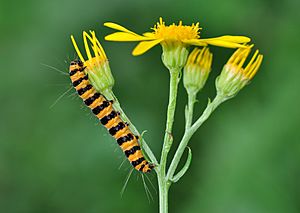Cinnabar moth facts for kids
Quick facts for kids Tyria jacobaeaeCinnabar moth |
|
|---|---|
 |
|
 |
|
| Tyria jacobaeae on ragwort plant | |
| Scientific classification | |
| Kingdom: | |
| Phylum: | |
| Class: | |
| Order: | |
| Family: | |
| Genus: |
Tyria
|
| Species: |
T. jacobaeae
|
| Binomial name | |
| Tyria jacobaeae (Linnaeus, 1758)
|
|
| Synonyms | |
|
|
The cinnabar moth (Tyria jacobaeae) is a very colorful moth. It belongs to a group called arctiid moths. You can find these moths in Europe and parts of Asia. They have also been brought to New Zealand, Australia, and North America. This was done to help control a poisonous plant called ragwort. The moth's caterpillars love to eat ragwort.
The moth gets its name from a red mineral called cinnabar. This is because of the bright red patches on its mostly black wings. Cinnabar moths are about 20mm (0.8 inches) long. Their wings can spread out to about 32–42 mm (1.3-1.7 inches).
Contents
About the Cinnabar Moth
Cinnabar moths fly during the day. This is different from many moths that fly at night. Like many other brightly colored moths, they are not good to eat. Their bright colors are a warning sign to predators.
What Cinnabar Moths Eat
The caterpillars of the cinnabar moth eat plants from the Senecio family, like ragwort. When they first hatch, the tiny caterpillars eat from under the ragwort leaves. They also eat near where their old eggs were.
These caterpillars take in toxic and bitter substances called alkaloids from the ragwort. This makes them taste bad and unsafe for most animals to eat. The bright colors of both the caterpillars and the adult moths act as a warning. Because of this, predators usually leave them alone. However, some types of Cuckoo birds can eat hairy and poisonous caterpillars, including the cinnabar moth larvae.
Caterpillar Habits
Female cinnabar moths can lay up to 300 eggs. They usually lay them in groups of 30 to 60 eggs. When they first hatch, the caterpillars are a pale yellow color. As they grow, they develop their famous jet black and orange or yellow stripes.
Caterpillars can grow up to 30mm (1.2 inches) long. They are very hungry eaters! Large groups of caterpillars can completely strip patches of ragwort plants. This happens because not many animals eat them.
Many caterpillars do not survive to become pupae. This often happens because they eat all their food before they are fully grown. They can die from starvation. Sometimes, cinnabar caterpillars might even eat other cinnabar larvae. This can happen if there isn't enough food. Sometimes, they do it for no clear reason.
Controlling Ragwort Plants
The cinnabar moth has been helpful in controlling ragwort. It works well as a natural pest controller. This is especially true when used with the ragwort flea beetle. This method has been successful in the western United States.
Images for kids
See also
 In Spanish: Polilla cinabrio para niños
In Spanish: Polilla cinabrio para niños










